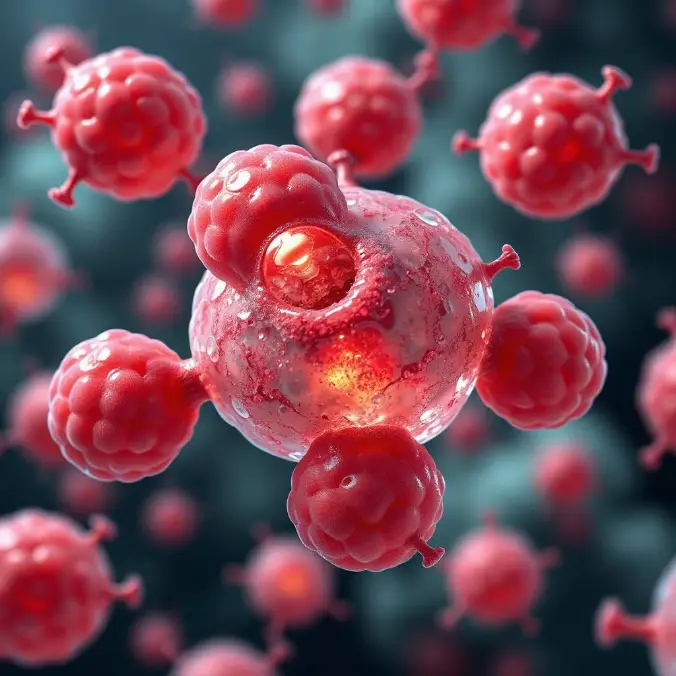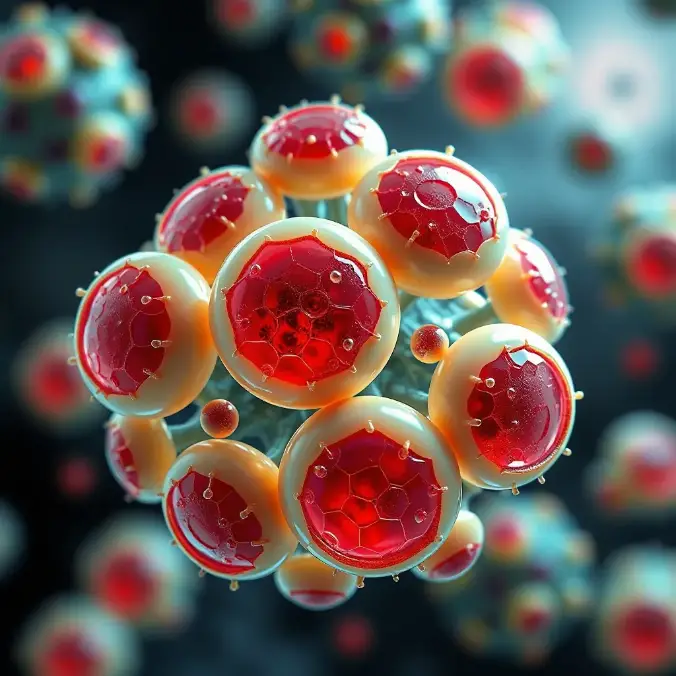What is Desmoplastic Small Round Cell Tumor and Its Symptoms

Desmoplastic small round cell tumor (DSRCT) is a rare and aggressive type of cancer. Explore Our Full Cancer Types Directory. It belongs to a group of soft tissue sarcomas and often develops in the abdomen. This tumor primarily affects adolescents and young adults, with the highest incidence in individuals aged 20–24 years. Males are more likely to develop DSRCT than females, and African-Americans show a slightly higher prevalence compared to Caucasians.
Early detection plays a crucial role in managing this condition. If you notice unusual symptoms, consult a healthcare professional promptly.
Demographic Group | Incidence Rate (cases/million) | Notes |
|---|---|---|
Overall | Age-adjusted incidence rate from SEER data | |
Males | 0.4 | Higher prevalence in males (p < 0.001) |
Females | 0.1 | |
African-Americans | 0.5 | Higher than Caucasians (0.2, p = 0.037) |
Caucasians | 0.2 | |
Peak Incidence Age Group | 20–24 years |
Key Takeaways
Desmoplastic small round cell tumor (DSRCT) is a rare cancer. It mostly affects young men aged 20 to 30.
Finding it early is very important. See a doctor if you have strange belly symptoms.
Common signs include a big lump in the belly, swelling, or pain. Watch for lasting changes in your body.
Treatment usually includes surgery, chemotherapy, and radiation. Using these together can help people live longer.
Support groups can help with feelings and give useful resources for people with DSRCT.
What is Desmoplastic Small Round Cell Tumor?

Overview of DSRCT
Desmoplastic small round cell tumor is a rare and aggressive cancer that primarily affects adolescents and young adults, especially males aged 20–30 years. This tumor typically develops in the abdominopelvic region, forming large masses in the abdominal cavity along with smaller peritoneal implants. Its highly malignant nature makes it challenging to treat.
Histologically, the tumor consists of small, round blue cells arranged in well-defined nests surrounded by dense connective tissue, known as desmoplastic stroma. Specialists use immunohistochemical markers like desmin, vimentin, and WT-1 to identify the tumor. A specific genetic abnormality, the EWSR1-WT1 gene fusion, plays a crucial role in confirming the diagnosis.
If you or someone you know experiences unusual abdominal symptoms, seeking medical advice early can make a significant difference.
Causes and Risk Factors
The exact cause of desmoplastic small round cell tumor remains unclear. However, researchers have identified a key genetic change associated with this condition. This change involves a translocation between chromosomes 11 and 22. Unlike inherited mutations, this translocation occurs during a person’s lifetime.
Genetic Change | Description |
|---|---|
Translocation | Involves chromosomes 11 and 22, acquired during a person's lifetime. |
Although no specific environmental or lifestyle factors have been linked to DSRCT, understanding its genetic basis helps doctors develop targeted treatment strategies.
Symptoms of Desmoplastic Small Round Cell Tumor

Common Symptoms
Desmoplastic small round cell tumor often presents with symptoms related to the tumor's size and location. You may notice a large mass in the abdomen, which is one of the most common signs. These masses are usually lobulated and can appear as soft tissue growths in the peritoneal, omental, or serosal regions. Imaging tests often reveal a dominant mass in areas like the retrovesical or recto-uterine space.
Other symptoms may include abdominal swelling or discomfort caused by the tumor's pressure on surrounding organs. As the tumor grows, it can lead to a feeling of heaviness or fullness in the abdomen. These symptoms often develop gradually, making it essential to pay attention to any persistent changes in your body.
If you experience any of these symptoms, consult a healthcare provider for further evaluation. Early detection can improve treatment outcomes.
Less Common Symptoms
In some cases, desmoplastic small round cell tumor may cause less obvious symptoms. You might experience abdominal pain or a sensation of fullness even without eating much. Some individuals report constipation or other signs of gastrointestinal obstruction, which occur when the tumor presses against the intestines.
An abdominal mass may also be detected during a physical examination, even if you don’t feel significant discomfort. These less common symptoms can sometimes delay diagnosis, as they may resemble other gastrointestinal conditions.
Paying attention to these subtle signs can help you seek medical advice sooner, potentially leading to earlier diagnosis and treatment.
Diagnosing Desmoplastic Small Round Cell Tumor
Initial Evaluation
Diagnosing desmoplastic small round cell tumor begins with a thorough evaluation of your symptoms and medical history. A healthcare provider will ask about any abdominal pain, swelling, or changes in bowel habits. They may also perform a physical examination to check for masses or tenderness in the abdomen.
Imaging tests play a crucial role in the initial evaluation. These tests help identify the tumor's size, location, and spread. Common imaging techniques include:
CT scans, which are often the first choice for detecting tumors in the abdomen.
MRI scans, which provide detailed images of the tumor and surrounding tissues. MRI is especially useful for identifying peritoneal metastasis.
These imaging methods can reveal whether the tumor appears as a solitary mass or multiple lobulated soft tissue growths in the abdominal cavity. Early imaging helps doctors plan the next steps in diagnosis and treatment.
Tip: If you experience persistent abdominal discomfort or swelling, seek medical attention promptly. Early evaluation can lead to better outcomes.
Confirmatory Tests
After the initial evaluation, confirmatory tests are necessary to diagnose desmoplastic small round cell tumor. A biopsy is the most definitive test. During this procedure, a doctor removes a small sample of the tumor tissue for analysis. Pathologists examine the sample under a microscope to identify the tumor's unique characteristics.
Special tests, such as immunohistochemistry, help confirm the diagnosis. These tests detect specific markers like desmin and WT-1, which are commonly found in DSRCT. Genetic testing may also be performed to identify the EWSR1-WT1 gene fusion, a hallmark of this tumor.
Blood tests and additional imaging may follow to assess the tumor's spread. These steps ensure an accurate diagnosis and help doctors develop an effective treatment plan tailored to your needs.
Treatment Options for Desmoplastic Small Round Cell Tumor
Standard Treatments
Treating desmoplastic small round cell tumor often involves a combination of therapies. Surgery is a key option, aiming to remove as much of the tumor as possible. This procedure, known as debulking, can significantly reduce the tumor burden. Chemotherapy is another standard treatment, especially for large tumors or cases where the cancer has spread. Doctors often use intensive alkylator-based chemotherapy to shrink the tumor before surgery.
Hyperthermic Intraperitoneal Chemotherapy (HIPEC) is a specialized approach used during surgery. It involves washing the abdominal cavity with heated chemotherapy drugs to target any remaining cancer cells. Radiation therapy is also common. It uses high-energy beams to destroy cancer cells and may be delivered externally or internally. For some patients, whole abdominopelvic radiotherapy is considered, though it carries potential side effects.
Multimodal treatment, which combines surgery, chemotherapy, and radiation, has shown promising results. Studies indicate that patients undergoing this approach experience improved survival rates compared to those receiving chemotherapy alone.
Additional Therapies
Researchers are exploring experimental therapies to improve outcomes for patients with desmoplastic small round cell tumor. Clinical trials are testing innovative treatments, such as targeted therapies and novel drug combinations. For example, a Phase 1/2 trial is investigating the combination of ramucirumab, cyclophosphamide, and vinorelbine to improve progression-free survival (NCT04145349). Another trial is evaluating the tolerability of irinotecan, temozolomide, and bevacizumab (NCT01189643).
Other experimental approaches include intraperitoneal radioimmunotherapy (IP RIT) and prexasertib combined with irinotecan. These therapies aim to target cancer cells more precisely while minimizing damage to healthy tissues. Participation in clinical trials offers hope for patients seeking cutting-edge treatments.
Supportive Care
Supportive care plays a vital role in managing the symptoms and side effects of treatment. Pain management is a priority, as patients often experience discomfort due to the tumor or its treatment. Medications, physical therapy, and relaxation techniques can help alleviate pain.
Nutritional support is equally important. Maintaining a balanced diet can improve energy levels and support recovery. Some patients may benefit from working with a dietitian to address specific dietary needs. Emotional support is also essential. Counseling, support groups, and mental health services can help patients and their families cope with the challenges of living with cancer.
Tip: Combining medical treatments with supportive care can enhance your quality of life during and after treatment.
Prognosis and Recurrence of Desmoplastic Small Round Cell Tumor
Prognosis Factors
The prognosis for desmoplastic small round cell tumor depends on several factors, including tumor location, treatment approach, and disease stage. Tumors located outside the abdomen often respond better to treatment, leading to improved survival outcomes. Surgical resection plays a critical role in prognosis. Patients with non-metastatic, intra-abdominal tumors who undergo surgery have a median survival of 47 months compared to 16 months for those who do not. Radiotherapy also significantly impacts survival, with patients receiving it achieving a median survival of 47 months versus 14 months for those who do not.
Factor | Description | Survival Outcome |
|---|---|---|
Tumor Location | Extra-abdominal vs. intra-abdominal | Extra-abdominal patients survived longer (P = 0.0246) |
Surgical Resection | Non-metastatic intra-abdominal disease with surgery vs. without | MS of 47 months with surgery vs. 16 months without (P = 0.0235) |
Radiotherapy | Patients receiving radiotherapy vs. those who did not | MS of 47 months with radiotherapy vs. 14 months without (P = 0.0147) |
The presence of distant metastasis negatively affects survival. Patients with metastasis face a higher risk of mortality, with a hazard ratio (HR) of 4.75 (P = 0.001). However, radiotherapy reduces mortality risk, with an HR of 0.45 (P = 0.008). Multimodal treatment, which combines surgery, chemotherapy, and radiotherapy, offers the best outcomes.
Tip: Early diagnosis and aggressive treatment improve survival rates. Discuss all available options with your healthcare team.
Recurrence
Recurrence remains a significant challenge for patients with desmoplastic small round cell tumor. The median recurrence-free survival (RFS) is approximately 14 months. Even after aggressive treatment, many patients experience a return of the disease. Factors such as incomplete surgical resection or the presence of metastasis increase the likelihood of recurrence.
Long-term outcomes vary widely. Some patients achieve long-term remission or even a cure, especially with advanced treatments like cytoreductive surgery (CRS) combined with hyperthermic intraperitoneal chemotherapy (HIPEC). This approach has shown a 3-year overall survival rate of 79% and a median RFS of 14 months. Advancements in treatment continue to improve survival rates and offer hope for better outcomes.
Note: Regular follow-ups and monitoring are essential to detect and manage recurrence early.
Desmoplastic small round cell tumor (DSRCT) is a rare but aggressive cancer that requires early detection for better outcomes. You’ve learned about its symptoms, diagnostic methods, and treatment options, which often involve a combination of surgery, chemotherapy, and radiation. Understanding these aspects can help you or your loved ones take proactive steps toward managing this condition.
Early detection and timely medical intervention can make a significant difference. Pay attention to persistent symptoms and consult a healthcare provider without delay.
If you or someone you know is affected by DSRCT, consider joining support groups. These communities provide a safe space to share experiences, exchange coping strategies, and amplify the collective voice for better resources. Surrounding yourself with a supportive network can make the journey less isolating.
Celebrate small victories, no matter how minor they seem.
Embrace positivity to inspire others and yourself.
Cherish every moment and engage in activities that bring you joy.
Gianna, a DSRCT survivor, reminds us of the power of hope and resilience. Her story encourages you to stay strong and find inspiration in the little things. With advancements in treatment and a supportive community, there is always hope for a brighter future.
FAQ
What makes DSRCT different from other cancers?
DSRCT is a rare and aggressive soft tissue sarcoma. It primarily affects the abdomen and occurs mostly in adolescents and young adults. Its unique genetic mutation, the EWSR1-WT1 gene fusion, distinguishes it from other cancers. Early detection and specialized treatment are crucial for managing this condition.
Can DSRCT spread to other parts of the body?
Yes, DSRCT can metastasize to other organs, including the liver, lungs, and lymph nodes. This spread often complicates treatment. Regular imaging and follow-ups help monitor the disease's progression and guide treatment decisions.
Is DSRCT hereditary?
No, DSRCT is not hereditary. The genetic mutation linked to this tumor occurs during a person’s lifetime. It does not pass from parents to children. Researchers continue to study its causes to better understand this rare cancer.
How long does treatment for DSRCT usually take?
Treatment duration varies based on the tumor’s size, location, and spread. A multimodal approach, including surgery, chemotherapy, and radiation, may take several months. Clinical trials or additional therapies could extend the timeline.
Are there support groups for DSRCT patients?
Yes, many organizations and online communities offer support for DSRCT patients and their families. These groups provide emotional support, share resources, and connect you with others facing similar challenges. Joining a support group can help you feel less isolated.
Tip: Ask your healthcare provider for recommendations on reliable support networks.
See Also
Understanding Ductal Carcinoma In Situ And Its Signs
Exploring Cutaneous T-Cell Lymphoma And Its Indicators
Defining Invasive Ductal Carcinoma And Its Warning Signs
